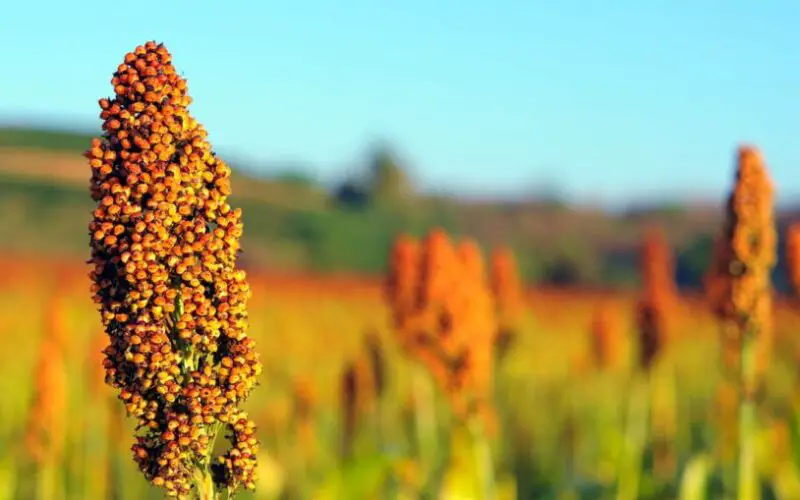It forms a large stem that can reach 9 ft in height, with a terminal inflorescence in red panicle that gathers spikelets of bisexual flowers, and leaves that start from the stem, all over its height. The seeds can be black, red or white according to the varieties which contain more or less tannin.
Its cycle is relatively short and, depending on the climatic and watering conditions, several harvests can be made the same year.
Sorghum does not contain gluten, which makes it increasingly interesting these days, given the number of people who are turning to gluten-free diets. On the other hand, it does contain proteins, amino acids and vitamins, which are valuable. Depending on the variety, it has many uses.
Contents
Where should sorghum be planted?
Sorghum can be grown in full sun in warm regions without the nature of the soil being too important.
When to plant sorghum ?
Sowing is done around May-June: the sorghum seeds are planted about 1 inch deep, spacing the plants 18 inches apart and the rows 23 inches apart. After covering the seeds, the soil should be compacted and watered.
Planting sorghum
Grain sorghum is sown directly in May, during the first two weeks of the month, in furrows about 2 inches deep and 23 inches apart.
It must be sown in the ground. Its height does not allow indeed a culture in pot. The ground must be worked beforehand on 18 inches of depth in order to make the ground flexible.
Culture and maintenance of sorghum
The culture of sorghum presents a real ease of conduct.
Sensitive to weed competition, it is important to weed chemically or manually from the 3 leaf stage of the crop.
As it has low water requirements, water until mid-July, when the grain becomes milky, after which it no longer needs water.
Sorghum efficiently takes up available mineral nitrogen from the soil, which moderates its need for nitrogen fertilizer. Moreover, 40% of the nitrogen and 80% of the potassium taken and stored in the vegetative parts are restored the following spring during the degradation of these organs.
This nitrogen benefits the following crop. This plant does not require tillering or other soil work during the crop.
On a small plot, the risk of lodging is practically null except in regions strongly exposed to the wind (mistral, tramontane) where it is good to foresee a sheltered place.
Provide a protection net against birds which can be very consuming of grains.
Sorghum harvesting
The harvesting period of sorghum differs according to the species chosen. Some are very early, early or late.
In all cases, it is advisable to wait until the grains are hard before harvesting grain sorghum.
Considered as a gluten-free cereal, sorghum is frequently used in the diets of diabetics or people suffering from food intolerances. Sorghum grains are rich in protein and amino acids.
When and how to harvest?
Sorghum is harvested on average 110 to 140 days after sowing, generally in September to mid-October, when the grains have become hard. It is harvested by hand. Either you cut the heads or you pull the whole plant and cut the heads later.
The panicles must be dried properly and then beaten to separate the grains from the panicles which will then be stored in well ventilated bags.
Sorghum conservation
Sorghum seed must be stored at 15% moisture, which is not always easy to do. At more than 22%, the seeds deteriorate very quickly. They heat up and molds develop quickly.
The drying techniques depend on the moisture content of the harvested seeds. According to this rate, seeds will be either ventilated or dried. The stored seeds are regularly ventilated in order to stabilize the hygrometry rate.
Diseases and pests of sorghum
There is a large number of diseases, insects and viruses of sorghum, however in France the problems are relatively low. The best sanitary approach consists, as often, in prevention, by choosing the species, variety, according to the use and the surface to be produced.
In the context of a small garden plot, these sanitary problems are very low. Beware of slugs and snails on young plants.
Cultivars with open panicles are generally less susceptible to pest larvae attacks and tolerate grain damage better than cultivars with compact panicles.
Similarly, “bearded” cultivars suffer fewer losses from seed-eating birds.
If needed, you should treat symptomatically. General treatments are reserved for industrial growers who unfortunately, as is often the case in monoculture situations, have to over-spray.
Organic vegetable production has become more important in many countries, because the application of pesticides is less than on other agricultural lines that are subject to treatments during and after harvest. This is the main reason why organic vegetables are the first products in demand.









